Your Sunday deserves a chewy inside and crunchy outside Ube mochi waffles. Learn the step by step and make them by the stack while in PJs. This recipe is straightforward. By crossing between Japanese mochi and the luscious taste and texture of Belgian waffles, you will create the ultimate and most memorable homemade dish for breakfast.
Ube mochi waffles combine unique taste elements with exceptionally chewy centers to create a light, crispy, and amazing flavor combination perfectly suited for any palate. It has a sweet, nutty flavor that brings new life to the Filipinos' traditional purple yam.
Jump to:
Watch the video
Ube Mochi Waffles - A Breakfast Delight That Doubles as a Mouthwatering Dessert
What is Ube?
Ube - [pronounced as "ooh-bay"] - is a type of purple yam. It is not the same as purple potatoes. This vegetable is trendy in desserts consumed by the Filipinos. It is a sweet-tasting vegetable that has a touch of a nutty taste. Use to create wide assortments of cakes, ice creams, and other types of sweet treats.
Sold in many different forms, the most popular – to date – is the "halaya," a type of sweet jam consumed alone or used as a type of spread for toast, bread, and other items.
Are the Ingredients Difficult to Locate?
Depending on where you reside, the ingredients may be challenging to locate; however, most stores that specialize in Asian groceries and/or foods have all of them.
Continue reading to learn which ingredients you will need and where you can locate them.
Ingredients that may be difficult to find:
- Ube Extract -You may find this on the baking aisle of the grocery store where you shop; however, this will depend on where you are located. If you have no luck, you may purchase this extract directly from Amazon.
- Ube Halaya - If you know of an Asian market or other Filipino market types, you will be able to find this ingredient in the aisle that specializes in spreads and jams. If not, you will have to resort to obtaining this from Amazon online.
- Sweet Rice Flour – I recommend using Mochiko. You can find this on the aisle in your favorite grocery store that sells Asian products. If not, you can purchase this at a market specializing in Asian foods or online at Amazon.
How to freeze Ube mochi waffles
This is an excellent question. I highly suggest that you continue reading this important information and that you engage in this process. These are a wonderful meal and may be placed in a freezer for 1-3 months.
- Let the waffles cool down before storing.
- You can flash freeze them for an hour until solid.
- Then, transfer them into a Ziplock bag and squish out as much air as possible. You can use a straw to suck the air out.
- Label with the date and place them back in the freezer; the waffles will last for up to three months.
Make ahead and freeze them
When cooking the waffles, you should not cook them completely if you plan to freeze them. Just prepare them in your waffle maker on a medium setting and cook halfway.
By undercooking, you can complete the cooking process in a toaster when you remove them from the freezer. This will provide the perfect crust on the outside and that chewy interior that we all love.
How to Reheat Frozen Waffles
I usually reheat waffles in the air fryer since I rarely reheat them in large quantities.
- Preheat the fryer at 360°F, place the frozen waffles in and cook for about 2 to 3 minutes. Note that I'm reheating mini waffles; therefore, time will vary depending on the size.
- If you don't have an air fryer, try using a toaster. The reheating process is pretty self-explanatory. Position the frozen waffles and toast them over a preheated toaster on a medium-heat setting for about 2 or 3 minutes—time varies depending on the size.
Ube vs sweet potato
This is a special type of indigenous-based tuber that is known in the Philippines. It is known for its nutty and delightful taste and its gorgeous purplish coloring. Many confuse it with the widely-popular purple sweet potato, but it is an entirely different type of root vegetable.
The Okinawan sweet potato that is purple is often confused with the ube. This has pale, brownish-colored skin with a center that is a deep purple color. The roots of the ube have a darker-colored skin and a center that is light to rich purple.
One dessert that is widely popular based on their usage of the ube is the ice cream company, Magnolia. It is used on "halo-halo" and in several other products. Since the emergence of this, many other products are now sold that contain ube. These include milk teas, cheesecakes, cookies, and now, waffles!
Just try out the pancake and waffle mix at Trader Joe's sold as "Ube Mochi." Once you try it, you will crave this luscious and highly-distinguished flavor. It is effortless to create ube waffles – all on your own – that has a crispy crust and a chewy, gooey inside that will amaze you!
Using Ube puree or Ube halaya
Due to its immense popularity, it's been a challenge to locate the fresh roots at the local Asian grocery stores. If you look through the freezer section, though, you will be pleased to find that most are selling ube puree in packets.
These packets contain real ube and not processed. If you use this in recipes, we recommend purchasing several packages to store in your freezer. If you cannot locate these fresh puree packets, you may buy "ube halaya" jam as an alternative for your ube recipes.

Pro Tips:
- When you use the puree packets, it is best to combine some water not to be as thick. If it is too thick, you will not end up with the chewy and light-textured ube waffles you crave.
- It is common, during the cooking process, to become very thick. You often see this in other instances, such as the cooking preparations for taro milk tea when boiling the taro root and the purple-colored sweet potato.
- To increase the flavor and the purple tint, just add ube extract to your recipe. While these are sold in artificial varieties, we suggest getting fresh ube extract for your recipes. You will instantly find that the taste is enhanced and that the coloring is exceptionally bright and vibrant.
Pro cooking tips
I have now – successfully – made several dozens of these wonderful tasting waffles. I am going to share my secret tips on creating the most pleasing ube waffles:
You will need several different flours. These include tapioca starch/flour, all-purpose flour, and rice flour.
Combining these three flours will create a lovely balance when it comes to the crispy outer layer and the chewy, tasty centers for this recipe.
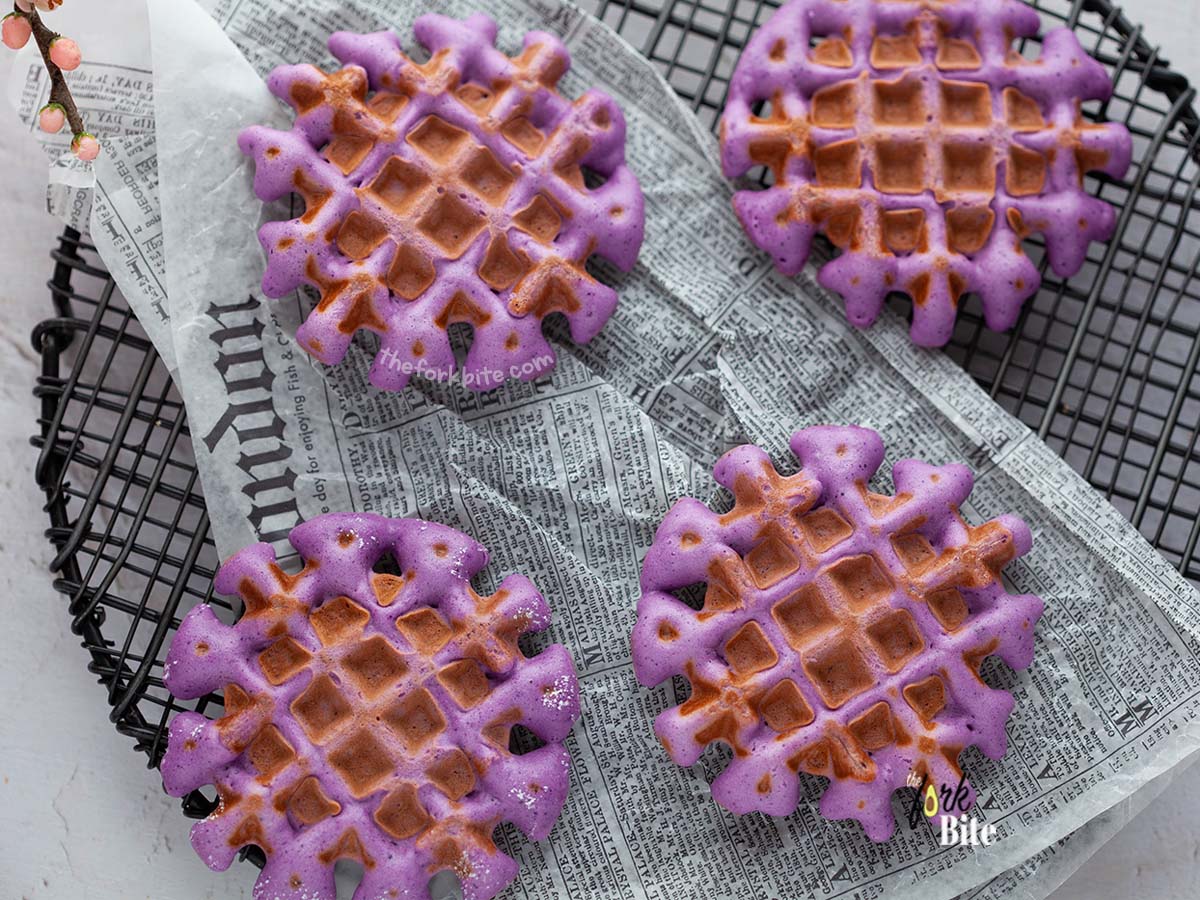
Note:
- If you add a larger amount of tapioca flour, you will have a chewier waffle.
- If you add more rice flour, you will have a crispier crust.
- The all-purpose flour helps in creating the overall softness and general density of your waffles.
Vietnamese and Asian supermarkets are selling all of these flour varieties.
Glutinous rice vs regular rice flour
Remember, glutinous rice flour and standard rice flour are completely different. You should never substitute one of these flours for the other. If you try to use glutinous rice flour, your waffles will come out quite sticky.

- You should mix the puree, ube extract, and the water before adding it to the other wet-based ingredients. This way, the puree will evenly distribute in the recipe.
- Always sift your flours before adding to your batter; this will ensure no lumps in your batter.
- Once you have prepared your batter, you should leave it on the counter to rest for about an hour. This will aid in the baking powder's overall development. It will have a slight bubble to it and will be much smoother if you take this step.
- To evenly cook the waffles, make sure you cook at medium heat to medium-high heat. If you have a waffle timer, use it. I typically wait about 30 seconds longer after it indicates completion to ensure that I have a nice crisp on the finished product.
- Once your waffles are done, place them on a cooling rack so that they may rest for about 30 seconds. Doing this helps the exterior become a bit crispier. Serve them immediately after that to enjoy the best in both texture and taste.
Make ahead and storage tips
If you like, you may pre-make the batter for your waffles and store it in your refrigerator for a couple of days before use. It is also possible to freeze any leftover cooked waffles for 1-3 months.
Just be sure the container is air-tight. When ready to eat, place them in the toaster. You will be amazed at the flavor!

Importance of using a kitchen scale
Flour is known to compact when you use tools. The other ingredients require volumetric measuring. To ensure that your recipe is accurate, you should use a kitchen scale.
Chewy mochi inside and crispy outside Ube waffles
If you would like to create an extra special breakfast treat, follow this recipe – which makes a chewy mochi inside and a crispy, golden-brown outside ube mochi waffle.
Grab these ingredients
Ube Halaya Mixture:
- 134 g Ube Halaya (or Ube puree)
- ½ c water
- 1 tablespoon Ube extract
For Waffle Batter (wet ingredients):
- 1½ cup milk (or use 13oz in can coconut cream)
- 2 eggs
- 1 tablespoon oil (use the neutral oil)
- Ube Halaya mixture (from above ingredients)
I used (1.5 cups + 2 tbsp), the result of the mochi texture turned out perfectly. Therefore, I ended up creating a new set of waffle batter (dry ingredients) and used the leftover (for wet ingredients).
For Waffle Batter (dry ingredients):
- 290 g Tapioca starch
- 70 g all-purpose flour
- 73 g rice flour
- 2 teaspoon baking powder
- 1 cup of sugar
- ¼ teaspoon salt
Step by step instructions
For Ube Halaya Mixture:
- Combine ube halaya or ube puree (if using) and ube extract by adding them to a bowl and whisking in your water very slowly. Make sure it is mixed as evenly as possible. Add the puree first, then the extract. Set aside.

For Waffle Batter:
- Take a large mixing bowl and beat your eggs. You should then add your cooking oil and your choice of ube halaya mixture, milk (or coconut cream). Mix thoroughly.
- Sift the three flours together with baking powder. Then add salt and sugar (or sweetening alternative) to the bowl.

- Use a spatula or even a spoon composed of wood to mix both the wet and the dry ingredients. There would be a few lumps when done so, don't over mix.

- Cover the batter that you have created and allow it to rest for an hour. If you are pre-making the batter for cooking the waffles on another day, it is at this point; you can move the mixture into the refrigerator. If you do this, move it to the counter to sit for 20 minutes before cooking.
- Reheat the waffle maker on a medium-high setting – this is optimal for this recipe. However, if you're using a DASH mini waffle iron (this is the waffle maker that I used for this recipe), just plug it in, no temperature setting option.
- Spray or brush some oil. Fill it to your preference. I used an ice cream scooper or a disher and fill it with about 1 tablespoon batter; I like my waffles to look edgeless as per pictures. Since I was using the [mini waffle maker], I set the timer for about 1 minute and 30 seconds. The Mochi waffle came out very nicely.

- Once the waffle is ready, remove and place it on a cooling rack before serving.
- Let the waffles cool down a bit and serve immediately with your favorite toppings.
- If you have leftovers, place them in an air-tight container and the freezer for up to a month. When you are ready to eat them, use the toaster to heat.
Interesting recipes
- Cinnamon French Toast Sticks
- Mac and Cheese Breadsticks
- Ihop French Toast Copycat Recipe
- Cheese Tea Recipe
Full Recipe
Ube Mochi Waffles Recipe
Pin RecipeEquipments:
- Waffle maker
- ice cream scooper
Ingredients:
Ube Halaya Mixture:
- 134 g Ube Halaya (or ube puree)
- ½ c water
- 1 tablespoon Ube extract
For Waffle Batter (wet ingredients):
- 1½ cup milk (or use 13oz in can coconut cream)
- 2 eggs
- 1 tablespoon oil (use the neutral oil)
- Ube Halaya mixture (from above ingredients)
For Waffle Batter (dry ingredients):
- 290 g Tapioca starch
- 70 g all-purpose flour
- 73 g rice flour
- 2 teaspoon baking powder
- 1 cup sugar
- ¼ teaspoon salt
Watch the Video:
Instructions:
For Ube Halaya Mixture:
- Combine ube halaya or ube puree (if using) and ube extract by adding them to a bowl and whisking in your water very slowly. Make sure it is mixed as evenly as possible. Add the puree first, then the extract. Set aside.
For Waffle Batter (Wet Ingredients):
- Take a large mixing bowl and beat your eggs. You should then add your cooking oil and your choice of ube halaya mixture, milk (or coconut cream), or your extract. Mix thoroughly.
- In a separate bowl, sift the three flours together with baking powder. Then add salt and sugar (or sweetening alternative) to the bowl. Set aside. (Read the next step below for UPDATE).
Mixing Dry + Wet Ingredients:
- UPDATE: For my second attempt, I decided to experiment by [ADDING ONLY the HALF AMOUNT of the batter wet ingredients into the dry ingredients]. I used (1.5 cups + 2 tbsp), the result of the mochi texture turned out perfectly. Therefore, I ended up creating another set of waffle batter (dry ingredients) and used the leftover (wet ingredients).
- Use a spatula or even a spoon composed of wood to mix both the wet and the dry ingredients. There would be a few lumps when done so, don't over mix.
- Cover the batter that you have created and allow it to rest for an hour. If you are pre-making the batter for cooking the waffles on another day, it is at this point; you can move the mixture into the refrigerator. If you do this, move it to the counter to sit for 20 minutes before cooking.[**See Notes below.]
Cooking the Waffles:
- Spray some oil. Fill it to your preference. I used an ice cream scooper or a disher and filled it with about 2 tablespoon batter; I like my waffles to look edgeless as per pictures.
- Since I was using the [mini waffle maker], I set the timer for about 1 minute and 30 seconds. The Mochi waffle came out very nicely. Once the waffle is ready, remove and place it on a cooling rack before serving.
- Let the waffles cool down a bit and serve immediately with your favorite toppings.
Notes:
I used (1.5 cups + 2 tbsp), the result of the mochi texture turned out perfectly. Therefore, I ended up creating a new set of waffle batter (dry ingredients) and used the leftover (wet ingredients).
Recipe adapted from hungryhuy
Please note that all nutrition information are just estimates. Values will vary among brands, so we encourage you to calculate these on your own for most accurate results.

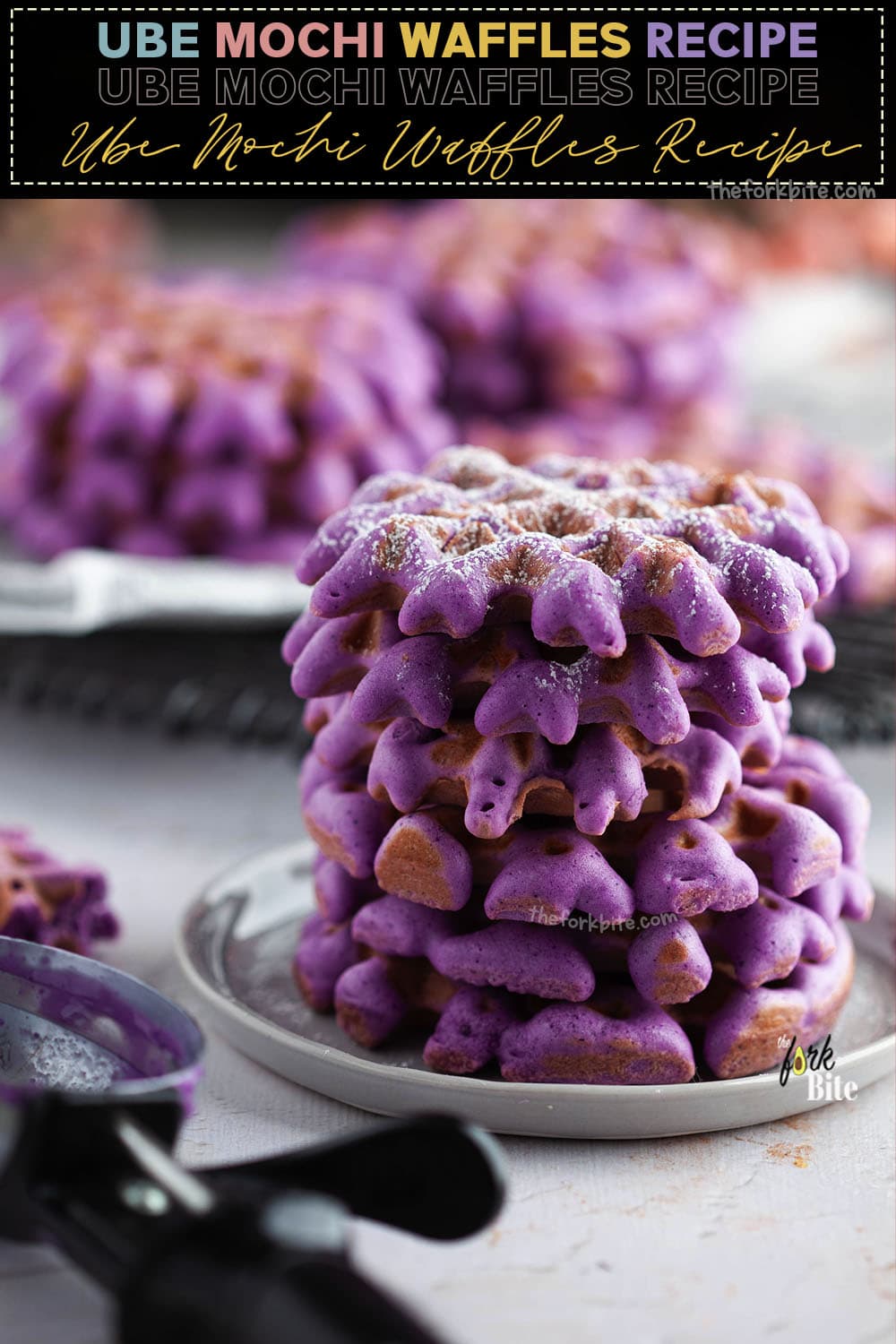
![Ube - [pronounced as ooh-bey] - is a type of purple yam. It is not the same as purple potatoes. This vegetable is trendy in desserts consumed by the Filipinos.](https://www.theforkbite.com/wp-content/uploads/2020/12/Ube-halaya-jam-12.31.20.jpg)

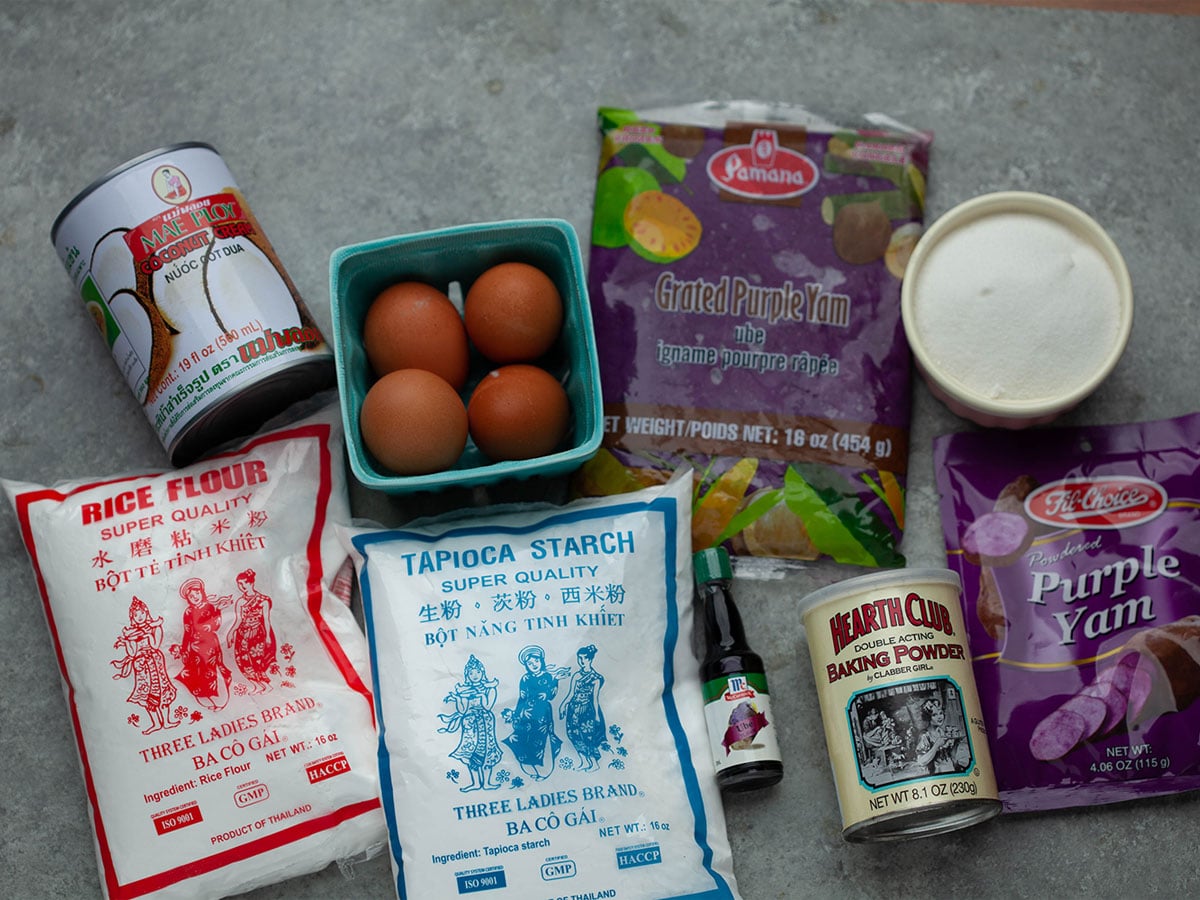
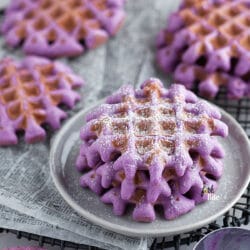
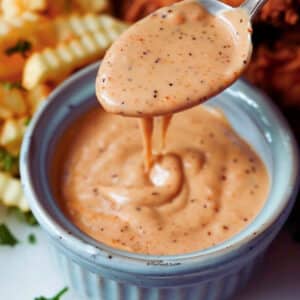
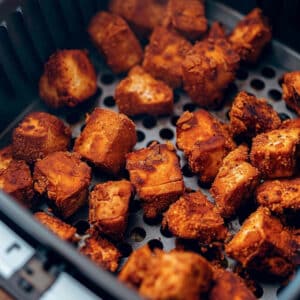
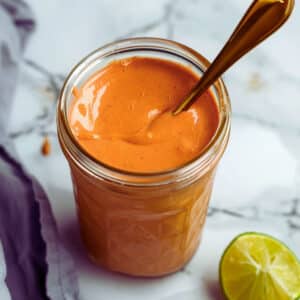
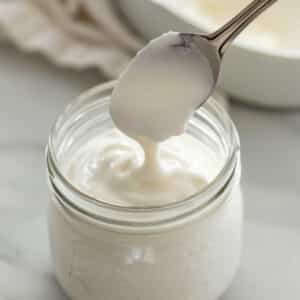
Calleigh says
Hi Maria,
Please use the rice flour (as per the picture from the ingredients), this is what I used for this recipe.
MARIADARMA CAPISTRANO says
I’m getting ready to try out this recipe, but I’m a bit confused. I understand that rice flour and sweet rice flour are not interchangeable, but your list of ingredients say rice flour but I see you recommend using Mochiko which is sweet rice flour. Please advise which rice flour the recipe calls for, thank you in advance.